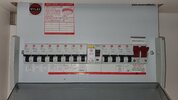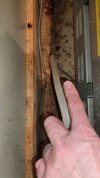The ovens are actually 3.6kW according to the NEFF manual.
You are using an out of date browser. It may not display this or other websites correctly.
You should upgrade or use an alternative browser.
You should upgrade or use an alternative browser.
What amp circuit required for 2 ovens and a hob
- Thread starter mav567567
- Start date
Yep ive since read the same. Depends where you look at the info.The ovens are actually 3.6kW according to the NEFF manual.
Not sure on cable size as unable to pull stove out to check and its the only place its exposed.Why don't you tell us what models of appliance you have in mind?
It would also be useful to see a pic of your consumer unit
And very very useful to know the size of your existing cable.
I previously had a range circuit with a 40A MCB.
Luckily there is no need to reposition your ovens, because electrical cables can run from one place to another.
See consumer unit attached
Attachments
Don't forget to comply with section 28 including the correct fuse/MCB rating in 28.8
See also https://www.diynot.com/diy/threads/myths.621544/page-6#post-5624058 post #89
See also https://www.diynot.com/diy/threads/myths.621544/page-6#post-5624058 post #89
Last edited:
Picture of cable. It looks thick but i know nothing.
You could try to measure it (accurately)
The easiest way I know to identify cables you don't see often (4mm for example) is to have a few cable clips in various sizes, and test which one fits easily, but tightly enough to need your thumb to get it off.
I don't know if DIY sheds sell mixed packs.
Trainers often have a board with a range of types and sizes clipped on to help build familiarity.
If you're in a shed, hold your measure against a few sizes and take a close up photo. Do the same with your own, and somebody will know what it is (it's PVC T&E, by the way)
Nominal sizes on here
A 6mm cable is probably what you've got. I can't see if it's plastered into a wall or packed in insulation.
Last edited:
Where?Ive read that diversity should not be applied to induction hobs
On forums such as this. No evidence to back it up.Where?
Ive read that diversity should not be applied to induction hobs
This is something I've heard of on a number of occasions but quite frankly have no idea about the mechanics of induction hobs. IF there is any truth in it I'd make a stab at a poor power factor, but that's as far as it goes.Where?
I've only encountered one in my working life and that was tripping a 20A RCBO on full load.
If that were true, the implication would be that induction hobs were grossly inefficient (very expensive to run) - which is the opposite of what I believe is the true situation..... Ive read that diversity should not be applied to induction hobs but again there is alot of opinion out there on this.
Kind Regards, John
In terms of efficiency, induction is significantly better than radiant or halogen, as the pan is what heats up, rather than some heating element heating and then transferring that heat to the pan.
Some induction hobs might have a peak load above that of more traditional heating elements, but as with any heating device, the various cooking areas won't be on at full power for very long, and as induction will heat things far quicker from cold compared to a radiant element, the power will be reduced very quickly.
Some are just on/off as with more traditional heating elements, others can vary the power output continuously. Either way, diversity certainly does apply.
Some can be downrated on installation to a certain maximum power, but that's not normally desirable unless the supply is limited (such as from an inverter, generator or some other situations such as a caravan).
Some induction hobs might have a peak load above that of more traditional heating elements, but as with any heating device, the various cooking areas won't be on at full power for very long, and as induction will heat things far quicker from cold compared to a radiant element, the power will be reduced very quickly.
Some are just on/off as with more traditional heating elements, others can vary the power output continuously. Either way, diversity certainly does apply.
Very likely, as most are rated 7kW+ just as radiant or halogen versions are.tripping a 20A RCBO on full load.
Some can be downrated on installation to a certain maximum power, but that's not normally desirable unless the supply is limited (such as from an inverter, generator or some other situations such as a caravan).
However at 7KW diversity would surely be covered by 20A.In terms of efficiency, induction is significantly better than radiant or halogen, as the pan is what heats up, rather than some heating element heating and then transferring that heat to the pan.
Some induction hobs might have a peak load above that of more traditional heating elements, but as with any heating device, the various cooking areas won't be on at full power for very long, and as induction will heat things far quicker from cold compared to a radiant element, the power will be reduced very quickly.
Some are just on/off as with more traditional heating elements, others can vary the power output continuously. Either way, diversity certainly does apply.
I've only encountered one in my working life and that was tripping a 20A RCBO on full load.
Very likely, as most are rated 7kW+ just as radiant or halogen versions are.
Some can be downrated on installation to a certain maximum power, but that's not normally desirable unless the supply is limited (such as from an inverter, generator or some other situations such as a caravan).
Getting back to gut feelings 20A must go well beyond 7KW to 8.5KW or more.
Last edited:
Exactly.In terms of efficiency, induction is significantly better than radiant or halogen, as the pan is what heats up, rather than some heating element heating and then transferring that heat to the pan.
Again, exactly.Some induction hobs might have a peak load above that of more traditional heating elements, but as with any heating device, the various cooking areas won't be on at full power for very long, and as induction will heat things far quicker from cold compared to a radiant element, the power will be reduced very quickly. Some are just on/off as with more traditional heating elements, others can vary the power output continuously. Either way, diversity certainly does apply.
"Diversity" is in effect a statement of the average energy consumption over a significant period of time with all the bits of the hob being used simultaneously, with each cycling on/off (or up/down in power) under thermostatic control. If "diversity could not be applied" to an induction hob, that would imply that the average consumption was equal to thee 'maximum possible consumption' (i.e. no thermostatic control) - which is a ridiculous suggestion and, as I said before, would imply ridiculously low efficiency (which we know is not the case).
Kind Regards, John
It would.However at 7KW diversity would surely be covered by 20A.
In fact,16A would very nearly 'cover it', even if it were 7kW at 230V - and if (very likely) it were 7kW at 240V, then 16A would 'cover it'.
Kind Regards, John
I'm glad I'm not going mad. I didn't do any calculations, just worked on gut feeling...It would.
In fact,16A would very nearly 'cover it', even if it were 7kW at 230V - and if (very likely) it were 7kW at 240V, then 16A would 'cover it'.
Kind Regards, John
But it has to be done.
Diversity of 7KW @ 230V = 16.13A, @ 240V = 15.75A
20A of diversity @ 230V = 9.966KW, @240v = 10.4KW
Well I'm gobsmacked, my gut let me down, I didn't expect those powers to be that high and certainly never thought It should be 6 or 10mm² to run an appliance on a 20A OCPD or that it was likely to only run for a minute if all switched on at the same time.
DIYnot Local
Staff member
If you need to find a tradesperson to get your job done, please try our local search below, or if you are doing it yourself you can find suppliers local to you.
Select the supplier or trade you require, enter your location to begin your search.
Please select a service and enter a location to continue...
Are you a trade or supplier? You can create your listing free at DIYnot Local
Similar threads
- Replies
- 6
- Views
- 4K



